Northern Thai is a Southwestern Tai language spoken mainly in northern Thailand, and also in northwestern Laos. There are about 6 million speakers of Northern Thai in Chiang Mai, Chiang Rai, Kamphaeng Phet, Lampang, Lamphun, Mae Hong Son, Nan, Phayao, Phrae, Sukhothai, Tak and Uttaradit provinces in Thailand, and another 29,500 in Oudomxai and Xiangnabouli provinces in Laos.
Northern Thai is the de facto language of provincial identity in the north of Thailand, an area that between the 13th and 18th centuries was known as La Na (อาณาจักรล้านนา คำเมือง), or the "Kingdom of a Million Rice Fields".
Nothern Thai was written with the Lanna or Thai Tham alphabet, and is generally written with the Thai alphabet these days.
Consonants are divided into three classes which help to determine the tone of a syllable (indicated by the numbers below). In the chart below is given first the Lanna letter, then the "Payanchana Sagot – พยัญชนะสะกด" if it exists (shown with the letter as a place holder), then the Thai equivalent, then the English equivalent (followed by IPA in square brackets). The numbers indicate the class of the consonant (used in determining the tone of the syllable). 1 – high, 2 – mid, 3 – low.
Payanchana Nai Wak - Categorized letters

Payanchana Nok Wak - Noncategorized letters

Payanchana Perm - Extra letters
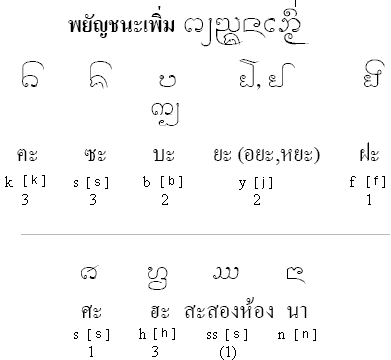
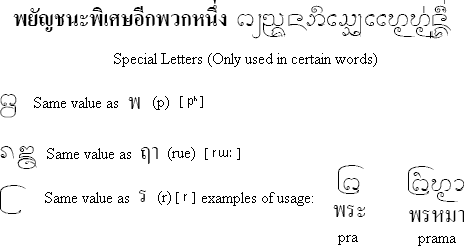
The vowels in the first column are the diacritic marks used to modify consonants. In the second column are the corresponding independent forms. Only certain vowels have this form. These are used for writing words borrowed from Pali. The third column is the Thai equivalent and the fourth is IPA. The dash in the Lanna column indicates the position of the consonant that the vowel is attached to.
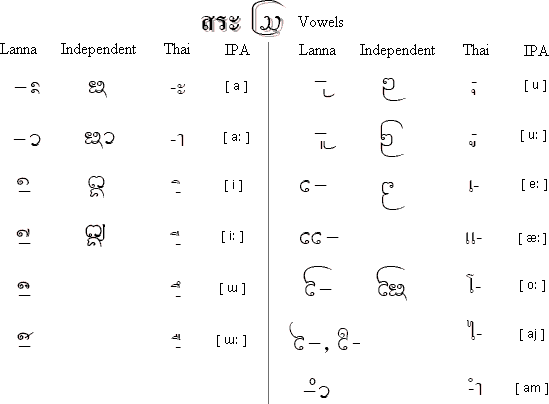
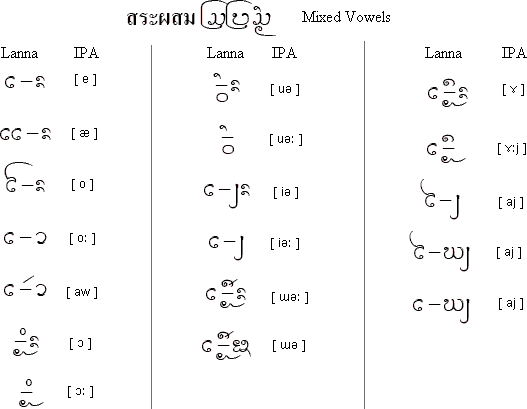
Lanna has two sets of numerals. The first set, Lek Nai Tam, is reserved for special purposes such as religious texts. The second set, Lek Hora, is the set usually used in everyday life. Its name (Hora) suggests that it is also used for astrological purposes.

The dash indicates the position of the letter that the diacritic mark is attached to.
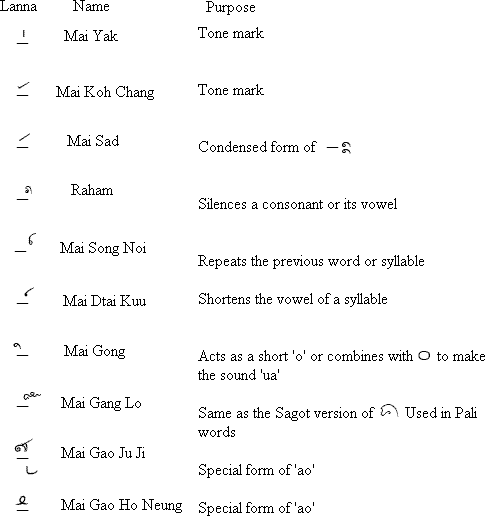

คติสอรไจโบราณล้านนา
๑ ทุกข์บ่ได้กิน บ่มีไผตามไฟส่องท้อง ทุกข์บ่ได้นุ่งอย้อง พี่น้องดูแฅวร
๒ เตมว่าที่กิน ที่นอรค่ดีคับ ยังอดอยู่ได้นานไพ คับค่ดีช้อม หัวอกหัวไจ จักอดอยู่ไพ หัวไจบิ่นบ้าง
Kadii Sawn Jai Boran Lanna
1. Dtuk bong dai gin biim ai tam fai sawn dtaang dtuk bong dai nung dai yawng bii nawng duu kwaen
2. Dtem wa dii gin dii non gaw dii gan yang od yuu doo non bpai gap gaw dii ngawm hua ok hua jai jak ok yuu boo hua jai bin baang
Lanna Fonts (TrueType, 597K)
Introduction to Lanna Alphabet (PDF, 201K, in Thai)
Information about Northern Thai
https://en.wikipedia.org/wiki/Northern_Thai_language
https://ru.wikipedia.org/wiki/Юан_(язык)
https://www.ethnologue.com/language/nod
Ahom, Aiton, Bouyei, Isan, Kam, Khamti, (Tai) Khün, Lao, Lue, Northern Thai (Kam Mueang), Nùng, Shan, Sui, Tai Dam, Tai Dón, Tai Hongjin, Tai Laing, Tai Nuea, Tai Phake, Tai Ya, Tai Yo, Thai, Thai Song, Yang Zhuang, Zhuang
Page last modified: 04.08.23
[top]
You can support this site by Buying Me A Coffee, and if you like what you see on this page, you can use the buttons below to share it with people you know.

If you like this site and find it useful, you can support it by making a donation via PayPal or Patreon, or by contributing in other ways. Omniglot is how I make my living.
Note: all links on this site to Amazon.com, Amazon.co.uk
and Amazon.fr
are affiliate links. This means I earn a commission if you click on any of them and buy something. So by clicking on these links you can help to support this site.
[top]